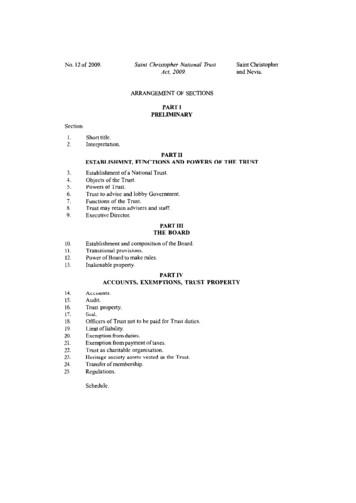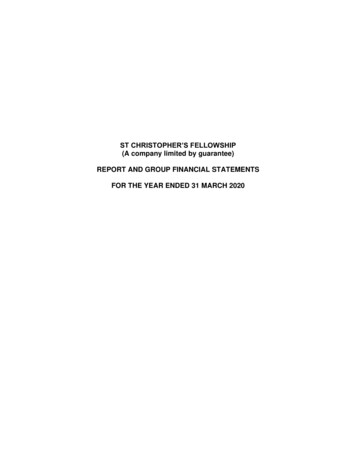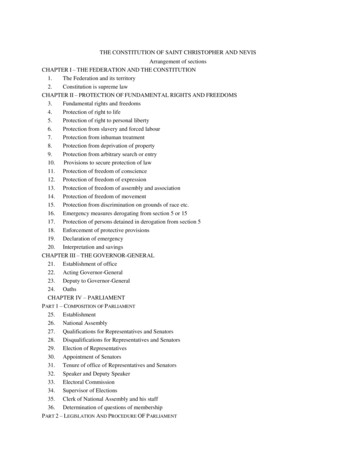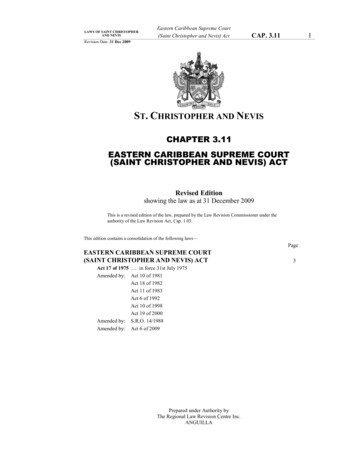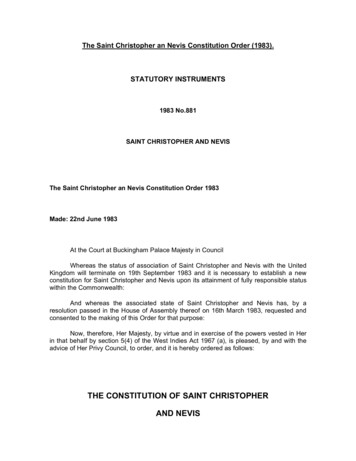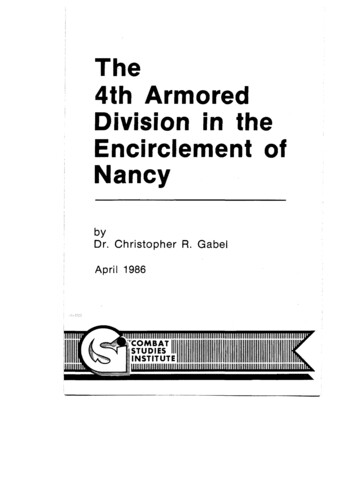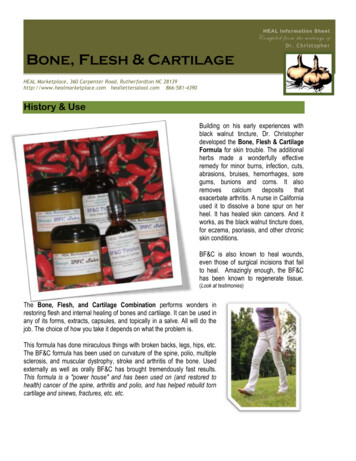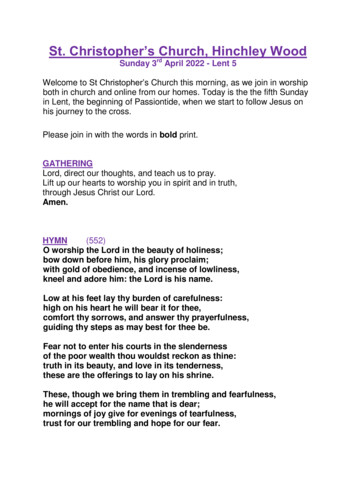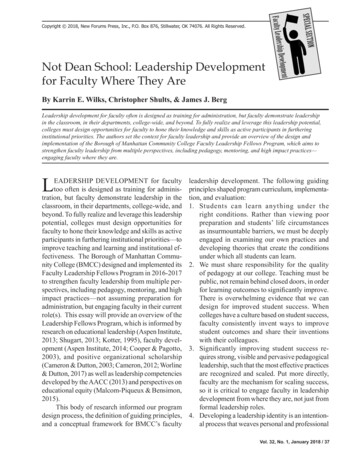
Transcription
Copyright 2018, New Forums Press, Inc., P.O. Box 876, Stillwater, OK 74076. All Rights Reserved.Not Dean School: Leadership Developmentfor Faculty Where They AreBy Karrin E. Wilks, Christopher Shults, & James J. BergLeadership development for faculty often is designed as training for administration, but faculty demonstrate leadershipin the classroom, in their departments, college-wide, and beyond. To fully realize and leverage this leadership potential,colleges must design opportunities for faculty to hone their knowledge and skills as active participants in furtheringinstitutional priorities. The authors set the context for faculty leadership and provide an overview of the design andimplementation of the Borough of Manhattan Community College Faculty Leadership Fellows Program, which aims tostrengthen faculty leadership from multiple perspectives, including pedagogy, mentoring, and high impact practices—engaging faculty where they are.LEADERSHIP DEVELOPMENT for facultytoo often is designed as training for administration, but faculty demonstrate leadership in theclassroom, in their departments, college-wide, andbeyond. To fully realize and leverage this leadershippotential, colleges must design opportunities forfaculty to hone their knowledge and skills as activeparticipants in furthering institutional priorities—toimprove teaching and learning and institutional effectiveness. The Borough of Manhattan Community College (BMCC) designed and implemented itsFaculty Leadership Fellows Program in 2016-2017to strengthen faculty leadership from multiple perspectives, including pedagogy, mentoring, and highimpact practices—not assuming preparation foradministration, but engaging faculty in their currentrole(s). This essay will provide an overview of theLeadership Fellows Program, which is informed byresearch on educational leadership (Aspen Institute,2013; Shugart, 2013; Kotter, 1995), faculty development (Aspen Institute, 2014; Cooper & Pagotto,2003), and positive organizational scholarship(Cameron & Dutton, 2003; Cameron, 2012; Worline& Dutton, 2017) as well as leadership competenciesdeveloped by the AACC (2013) and perspectives oneducational equity (Malcom-Piqueux & Bensimon,2015).This body of research informed our programdesign process, the definition of guiding principles,and a conceptual framework for BMCC’s facultyleadership development. The following guidingprinciples shaped program curriculum, implementation, and evaluation:1. Students can learn anything under theright conditions. Rather than viewing poorpreparation and students’ life circumstancesas insurmountable barriers, we must be deeplyengaged in examining our own practices anddeveloping theories that create the conditionsunder which all students can learn.2. We must share responsibility for the qualityof pedagogy at our college. Teaching must bepublic, not remain behind closed doors, in orderfor learning outcomes to significantly improve.There is overwhelming evidence that we candesign for improved student success. Whencolleges have a culture based on student success,faculty consistently invent ways to improvestudent outcomes and share their inventionswith their colleagues.3. Significantly improving student success requires strong, visible and pervasive pedagogicalleadership, such that the most effective practicesare recognized and scaled. Put more directly,faculty are the mechanism for scaling success,so it is critical to engage faculty in leadershipdevelopment from where they are, not just fromformal leadership roles.4. Developing a leadership identity is an intentional process that weaves personal and professionalVol. 32, No. 1, January 2018 / 37
narratives, both individual and collective, basedon history and the fictive future. Storytellingis essential to the development of leadershipidentity.5. Successful colleges collaboratively design forsuccess, a process that begins with dialogue anda collective understanding about what studentsuccess looks like in the classroom and acrossthe institution. There must be inquiry into what’sworking and what needs attention—all drivinga faculty culture of student success. Designingfaculty leadership programming must followthis same collaborative design principle.6. Building open and productive relationshipsacross departments and disciplines, amongtenured and untenured faculty, and amongfaculty and administrators is vital to creating acollaborative culture designed for student success, one that practices and celebrates teachingexcellence, the review of evidence, and ongoingexperimentation. We need to be able to havedifferent kinds of conversations.Fellows in developing follow-up session agendas,materials, presentation, and discussion facilitation.Additionally, self-reflection played a major rolethroughout the program. Both of these strategiescontributed to Fellows’ evolving narratives asfaculty leaders and the development of personalfaculty leadership commitments going forward.The ultimate goal is to encourage faculty to becomeactive participants in transformational change aimedat dramatically improving student success.This article is organized in four parts: 1) settingthe context of the program in relation to institutionalpriorities and values; 2) exploring the workingtheories behind the week-long seminar curriculumand the role of the Fellows in developing followup sessions; 3) the use of an original case study toanalyze leadership scenarios and approaches; and4) assessing the Program and making changes forthe next cohort.The BMCC Faculty Leadership FellowsProgram included a week-long seminar in January2017 and five follow-up sessions throughout thespring semester on specific topics generated by theparticipants. Fellows were nominated either by theirdepartment chair or by a member of the President’sCabinet. Nominees were notified and invited tosubmit an application that included their c.v. anda statement about their strengths as a leader, howthey view faculty leadership, and the challengesfacing the college and the City University ofNew York (CUNY). Fourteen participants wereselected from 18 applications, based on their currentleadership roles, current and past active roles atthe college, years of service to the institution, andtheir application statements. The Fellows camefrom twelve departments, including the largestdepartments at the college: Social Sciences, HumanServices and Criminal Justice (one department);Speech, Communications, and Theater Arts (onedepartment); and English. The Fellows were invitedto nominate faculty for the second cohort whichbegins in January 2018. Fellows included fivedepartment chairs, two deputy chairs, two programcoordinators, and several untenured faculty. A keyfeature of the curricular design was to engage theBMCC is one of 24 institutions, includingseven community colleges, in CUNY. BMCC isthe largest college in CUNY, serving over 27,000students with over 550 full-time and 1,000 parttime faculty. The student population at BMCC isnearly 45% Hispanic, over 30% Black, nearly 15%Asian, and under 10% White. Almost 80% of firsttime freshmen require remediation. The College’sstrategic plan is framed by a student progressionmodel that seeks to improve student success at eachkey transitional point in a student’s educationaljourney, from college readiness to remediationto the student experience to graduation, transfer,baccalaureate attainment, and ultimately a careerwith family-sustaining wages. BMCC’s highestpriority is improving retention and graduation rates.Not just a little, but dramatically.BMCC, like any college, cannot significantlyimprove student outcomes without strong, visible,and pervasive faculty leadership. Faculty arefundamental to creating a culture based on studentsuccess, a culture that respects and embraces thechallenges and opportunities related to studentsuccess, such that when students don’t succeed,faculty and staff routinely respond with theories ofchange. Most critically, this requires an examinationof fundamental beliefs, about our students and the38 / The Journal of Faculty DevelopmentSetting the Context: Defining andExpanding Faculty Leadership
work we do. Central to a culture based on studentsuccess is the belief that students can learn anythingunder the right conditions. Rather than viewingpoor preparation and students’ life circumstances asinsurmountable barriers (a deficit model), a sizablecoalition must be deeply engaged in examiningour own practices and inventing ways to improvestudent outcomes. Faculty leadership drives thedemand for change and deep engagement in ananalysis of our own actions.Developing the Faculty LeadershipCurriculumLeadership development programs can addressthe issues that faculty care about in a way that mayincrease their efficacy, impact the college culture,and contribute to improved teaching and learningand institutional effectiveness. Specific goals forFellows included developing a plan to optimizetheir roles as faculty leaders and making ongoingcontributions to the theory and practice of facultyleadership at BMCC. The Senior Vice Presidentand Provost, Dean of Institutional Effectiveness andStrategic Planning, and Associate Dean of Facultydeveloped the curriculum for the Fellows Programand facilitated or coordinated all sessions. (This isthe program development team, referred to below.)The five-day seminar addressed the followingissues:1. Transformational Leadership: Creating a Culture for Positive Change2. Leading to Support Teaching, Learning, andScholarly Inquiry3. The Role of the Community College: Access,Opportunity, and Workforce Development4. Leadership and Governance: College, University, State and Federal Policy5. Faculty Leader as Institutional Leader: Focuson Equity.The first topic, creating a culture for positivechange, was informed by positive organizationalscholarship literature, particularly by the workof Cameron and Dutton (2003) and Worline andDutton (2017). A panel of three community college presidents and chancellors spoke about theirjourneys to leadership and their work as and withfaculty. It is important to create an environment inwhich faculty may thrive in all aspects of their work,and Dr. Worline spoke about the value of compassion in the workplace.In developing pedagogical leadership, weconsidered the work of Ambrose, Bridges, DiPietro,Lovett, and Norman (2010). and seven principles forsmart teaching as they could be applied to leadershipdevelopment. In addition, we explored the role offaculty in helping students succeed, in and out ofthe classroom. Important issues for learners thatare also key to teachers include motivation, priorknowledge, and reflection. It is important to createa context in which faculty can be reflective abouttheir teaching, receive non-evaluative feedbackfrom their peers, and make teaching more public.The third day focused on the multiple missionsof the community college and the role of faculty inworkforce development. As a college with strongconnections to business and finance professions, wehave curricular pathways to those and other fields.Faculty in all disciplines need to understand theirrole in preparing students for the world of work,whether after an associate degree or after transfer anda bachelor’s degree. Recent work by Chetty, Friedman, Saez, Turner, and Yagan (2017) illustrates thesignificant upward income mobility experienced bygraduates from the CUNY system overall, not onlyin traditionally “occupational” fields.Governance is complicated in public highereducation where overlapping layers include city,state, federal and accreditation expectations, aswell as the role of CUNY in our case. Anotherpanel of senior leaders addressed the role of campusadministrators as extensions of the governing board,entrusted to follow all applicable rules and laws.Faculty tend to see “committee work” and “service”as limited parts of their positions. Yet they shapethe policies and procedures of the college, and theirwork in departments should enact the best structuresof shared governance.The final day examined the student successagenda and identified success gaps among groups ofstudents as a problem of practice. Malcom-Piqueuxand Bensimon (2015) show that equity is a measureof institutional effectiveness. Institutions can designfor equitable outcomes, and faculty can lead by being positively race-conscious when colleagues focuson student deficits. Faculty can engage one anotherin reflection and inquiry to address achievementgaps in their own courses and departments.Vol. 32, No. 1, January 2018 / 39
Each day included time for reflection in a variety of formats. The first day began with a writtenresponse to three questions:1. What are your goals for this program?2. What are the key assets you bring to your roleas faculty leader?3. What leadership challenges are you/your department/BMCC currently facing.making, mentoring for teaching and research,equity, and leadership identity. This collaborativecurriculum design was intentional and gave thefollow-up sessions an added sense of purpose andapplicability. At every session we invited Fellowsto share elements of their own stories, usingautobiographical narrative as a means of analyzingand strengthening leadership identity—transitioningfrom personal narrative to self-as-leader. This storyOn some days, questions were provided for telling made for rich and very direct conversationseither think-pair-share discussions or small group not always experienced with the Provost, two deans,discussions. Most days, individual written reflection and faculty in one room.was followed by small or whole group discussion,and each day, the final activity was a one-minute Using the Case Study as a Learningassessment focused on what resonated, what Tool for Faculty Professionalquestions remained, and what could be applied toDevelopmentindividual program goals. The final day ended withBuilding upon the theoretical framework andreflective writing and sharing in response to theinstitutionalphilosophies guiding the BMCC Facultyfollowing questions:1. What are the key elements of your theory of Leadership Fellows Program, we used the case studyas a tool to integrate the theoretical knowledge andcommunity college leadership?practical information in a hypothetical environment2. How do you lead from where you are?3. Where do you want to go in your leadership in which the Fellows could directly apply thelessons they were learning. Given that “despite thejourney?4. What resources within BMCC or CUNY are widespread use of case study methods throughoutthe social sciences, no consensus has emerged as toimportant to you on this journey?5. What do you plan to do differently as a result the proper definition, either of a case or a case study”(Levy, 2008, p. 2), the program development teamof this week?chose to implement a model that was guided byParticipants formalized this reflection in a written generally accepted practices within the field, whiledocument confirming goals, values, and a leader- meeting the needs unique to faculty development.Levy provides a useful typology of caseship statement.Competencies for community college admin- study approaches that provided guidance on whichistrators developed by the American Association of approach to take. The idiographic case studyCommunity Colleges (2013) were mapped against identified by the author is non-theoretical in naturethe topics over the five days of the seminar. The and is based on a foundational assumption that allcompetencies are organizational strategy, commu- aspects of the case are related to each other and thatnication, collaboration, advocacy, and institutional important learning can occur through examining thefinance, research, funding, and resource manage- interconnections inherent to the case. Another helpfulment. Communication and collaboration were resource was the Commonwealth Association forPublic Administration and Management (CAPAM,stressed throughout the week-long seminar.Follow up sessions were held on five Fridays 2010), which provided a meta-analysis of casein the following semester. The topics were chosen studies within the field of public administration. Anfrom suggestions made by the participants, and the examination of this important publication offeredFaculty Fellows were invited to help design and several examples of case studies that proved useful.deliver the sessions. For all sessions, a group of These included:Fellows worked with one of the program leaders to The Illustrative Case Study – An approach thatfocuses on the primary characteristics of a realdesign and facilitate the session. The topics wereworld setting;leadership communications, using data in decision40 / The Journal of Faculty Development
The Business School Approach – An approachthat emphasizes decision-making and decisionanalysis through a cause and effect methodology;andThe Field Case Study (Armchair Case Study)– A management or leadership concept ispresented by presenting a hypothetical scenario.The concept of presenting hypothetical scenarios offered a slightly different approach to themore traditional case study model. Nath (2005), inexamining the use of the case study approach fortraining educators, provided a similar model for thecase study. The author identified the supplementalscenarios case study method, which is an approachthat uses problem sets to allow for a more nuancedanalysis of a problem.Through the use of these important and variedinterpretations of the case study, the program development team designed a real-world setting thatwas constructed by taking information from dozensof institutions and utilizing a historical fiction approach in the creation of the narrative. We titled thishypothetical composite college Chavez-ChisholmCommunity College and created a fictional history,numerous academic programs and departments, anda set of internal (faculty, staff, and administrators)and external (Board members, activists, businessleaders, and politicians) actors. Over each of thefive themed days, the Fellows were provided withopportunities to hear from theorists, academics,administrators, and practitioners. Then they utilized the same case as a tool for applying their newknowledge each day. What changed, however, werethe unique problem sets that they addressed.These problem sets contained situationsaligned with the day’s theme and any informationprovided in the case (the College) could prove tobe relevant; however, it was up to the participantsto determine how to move forward in solving theday’s unique problem set. This method mirrors thesupplemental scenario model approach and greatlyenhanced the relevance and utility of the case. Theparticipants often had to confront the same actors,consider different approaches to similar problems,and in some cases, had to go back and attempt tosolve a problem that was not adequately addressedduring one of the previous days. As is typical withthe case study approach, there were no right orwrong answers, but rather, effective and ineffectiveapproaches that could either quell or further inflamedelicate situations.The participants received the case prior to thefirst day of the seminar. Each day, near the end ofthe session, they received their new problem set,group exercises were conducted, and opportunitiesfor reflection were provided. The Fellows workedin small teams to dissect the problem sets anddetermine what information from the case wasrelevant to addressing the day’s unique scenario.After discussing how to address the problem,the groups presented to the entire cohort and theprogram development team, were asked questions,and were provided with a constructive critique oftheir response. Again, the purpose of the exercisewas not to come up with a correct response, butrather to apply the knowledge learned that dayand to utilize different leadership and managementapproaches.Assessing the Program andPreparing for the Next CohortIn addition to formative assessments conducted throughout the program (discussed above), a finalsurvey was administered at the end of the program.Fellows rated the usefulness of each presenter andpanel; individual reflection, small group discussion,and whole group discussion; the case study andproblem sets; the reading list; and the use of the eportfolio. The focus on utility was intentional giventhe program goals for Fellows to develop a plan tooptimize their roles as faculty leaders and makeongoing contributions to the theory and practiceof faculty leadership at BMCC. An important partof the program design is to support faculty goingforward in strengthening their leadership roles at theCollege, both formal and informal, with particularattention to pedagogical leadership.Additionally, Fellows submitted their writtenresponses to the following questions to the programteam:1. To what extent did you achieve the goals youset for yourself?2. Which of your stated values are emerging asmost important in your leadership work?3. To what extent have you “lived” your leadershipstatement over the past semester? How?Vol. 32, No. 1, January 2018 / 41
4. In what area(s) have you grown the most as aleader since the beginning of the Fellowship?How do you know?5. In what area(s) do you still need to grow themost? How do you plan to achieve this growth?As of this writing, BMCC has recruited 16 facultyfor cohort two of the Faculty Leadership FellowsProgram.The BMCC Faculty Leadership FellowsProgram is designed to build a strong coalition, avibrant learning community of faculty leaders toimprove student success, ultimately to advanceequity and social justice. Part of the design is toensure ongoing roles of Fellows with the nextcohort and others, for example, through mentoringnew faculty. All members of the first cohortvolunteered to work with the second cohort, eitherthrough presentations at or facilitations of sessions,or brainstorming the revision of the case studyand problem sets. As reported by the Fellows,an important outcome of the first cohort was thedevelopment of strong and enduring relationshipsand commitments across disciplines and with keyadministrators, the foundation of our strengtheningfaculty leadership at BMCC.As we revised the curriculum for our secondcohort, we returned to the guiding principles thatformed the basis for our program design and theevolving design of our theory and practice of facultyleadership at BMCC. Designing for success must beintentional. This is not about preparing people forformal leadership roles as chairs or deans. This isabout our moral obligation and shared responsibilityfor creating the conditions under which all studentscan learn and where pedagogical leadership is heldin the highest esteem.These summative pieces provided richinformation about what was most meaningful tothe Fellows and how to revise the program goingforward. Survey responses and an analysis of writtenmaterials (formal assessment) as well as discussionheld during the follow up sessions impacted the2018 BMCC Faculty Leadership Fellows Programin four major ways. These include: Maintaining Positive Organizational Scholarshipas the underlying theoretical framework forthe Institute. Participants appreciated using astrengths-based framework to counteract thenegative impacts of engaging in deficit-modelapproaches. Adjusting the topics covered and sessionsprovided during the institute. Given that TheRole of the Community College and Leadershipand Governance days were the lowest rated,they have been revamped substantially andre-introduced as The Community CollegeMission: Policies for Access and Successand Leadership and Students: Faculty LedInstitutional Transformation, respectively.In both cases, presenters have been selectedwho can provide evidence for the redesign ofcommunity colleges to improve student successand link that to faculty leadership.References Reconfiguring the Case Study to encourage Ambrose, S.A., Bridges, M., DiPietro, M., Lovett, M., & Norman, M.K.(2010). How learning works: Seven research-based principles forfaculty to explore leadership at multiple levels.smart teaching. (2010). San Francisco: Jossey-Bass.During the first institute, faculty took on the role American Association of Community Colleges. (2013). AACC competenciesof Vice President for Academic Affairs duringfor community college leaders (2nd ed.). Washington, DC.AspenInstitute. (2014). Building a faculty culture of student success. Washall of the problem sets. The second cohort willington, DCaddress the problem sets in multiple roles thatAspen Institute. (2013). Crisis and opportunity: Aligning the communityinclude not only that of Vice President, butcollege presidency with student success. Washington, DC.also as an untenured faculty member, program Cameron, K. & Dutton, J. (Eds.). (2003). Positive organizational scholarship: Foundations of a new discipline. Oakland, CA: Berrett-Koehlercoordinator, department chair, and, ironically,Publishers.a dean.Cameron, K. (2012). Positive leadership: Strategies for extraordinary per Designing problem sets that reflect current difformance. Oakland, CA: Berrett-Koehler Publishers.ficulties experience by faculty within BMCC’s Commonwealth Association for Public Administration and Management.(2010). Overview of case study models and methodology. Ottawa,academic departments. Working with graduatesON: Author.from the initial cohort, new problem sets were Chetty, R., Friedman, J., Saez, E., Turner, N., & Yagan, D. (2017). Mobility report cards: The role of colleges in intergenerational mobility.developed that provide a more realistic andNational Bureau of Economic Research Working Paper No. 23618.relevant experience for the Fellows.42 / The Journal of Faculty Development
Cooper, J.E. & Pagotto, L. (2003). Developing community college faculty asleaders. New Directions for Community Colleges, 123, 27-37.Kanov, J. M., Maitlis, S., Worline, M. C., Dutton, J. E., Frost, P. J., & Lilius,J. M. (2004). Compassion in organizational life. American BehavioralScientist, 47(6), 808-827.Kotter, J.P. (1995). Leading change: Why transformation efforts fail. HarvardBusiness Review, March-April 1995.Levy, J.S. (2008). Case studies: Types, designs, and logics of inference.Conflict Management and Peace Science, 25, 1-18.Malcom-Piqueux, L. & Bensimon, E. (2015). Designing principles for equityand excellence at Hispanic-serving institutions. Perspectivas: Issuesin Higher Education Policy and Practice, 4.Nath, J.L. (2005). The roles of case studies in the educational field. International Journal of Case Method Research & Application, 17(3),396-400.Shugart, S. (2013). The challenge to deep change: A brief cultural historyof higher education. Planning for Higher Education, 41(2), 7-17.Worline, M. & Dutton, J. (2017). Awakening compassion at work: The quietpower that elevates people and organizations. Oakland, CA: BerrettKoehler Publishers.Karrin E. Wilks, Ed.D., is the Senior Vice Presidentand Provost at the Borough of Manhattan Community College. Previous positions include Provost atMedgar Evers College, University Dean for CUNY,and Senior Vice President for the Vermont StateColleges. She has served in public higher educationadministration for over thirty years and has extensive experience developing and evaluating policyand programs aimed at improving student learningoutcomes, particularly for underserved populations.kwilks@bmcc.cuny.eduChristopher Shults, Ph.D., is the Dean of Institutional Effectiveness and Strategic Planning at theBorough of Manhattan Community College. Priorpositions include Executive Director for Planningand Institutional Effectiveness and Associate Provost for Effectiveness, Assessment, Research, andStrategic Planning. Dr. Shults has more than 50presentations to his credit and regularly consults,presents, and writes on issues of institutional effectiveness, assessment, planning, institutionalresearch, and higher education leadership. cshults@bmcc.cuny.eduJames J. Berg, Ph.D., is Associate Dean of Facultyat the Borough of Manhattan Community College.He has been engaged in faculty professional development for over twenty years. He is the editor ofseveral editions of works by Christopher Isherwood,including Isherwood on Writing (2008). jberg@bmcc.cuny.eduVol. 32, No. 1, January 2018 / 43
The Active Learning Classroom:Strategies for Practical EducatorsThe goal of the book is simple: To improve studentachievement by helping teachers implementactive learning strategies in the classroom. To begin,consider the following two questions in relation toyour own classroom:1. Are your students activelyengaged throughout the entiretyof your daily lessons?2. Are students meeting yourhighest expectations regardingachievement?creative thinking, and problem-solving. Mostteachers agree that these skills are essential forincreasing student achievement; however, theseskills are difficult to foster in the traditional ‘sageon a stage’ model. Educators must learn to adopta new ‘guide on the side’ teaching paradigmwhereby traditional instructionis supplementedb y a c t i ve l e a r n i n gstrategies.The ContentsIntroduction / vChapter 1: FlippedClassroom / 1Chapter 2: CollaborativeGrouping / 11Chapter 3: InteractiveGames / 21Chapter 4: Self-Reflection/ 33Chapter 5: Learning byTeaching / 43Chapter 6: Interactive NoteTaking / 51Chapter 7: Engaging ClassTransitions / 61Chapter 8: Managing the ActiveClassroom / 71Afterword / 83About the Authors / 85If you answered ‘no’ to eitheror both of these questions,you are not alone. Classroomteachers at all levels arechallenged with low studentengagement, resulting inlow student achievement.Numerous studies indicatea positive correlationbetween engagementand achievement. Forthis reason, the teacheris the most importantcomponent of thelearning process, ashe/she is ultimatelyresponsible for creating anatmosphere conducive to student achievement.Active Learning has proven to be one of the mostimportant tools for engaging students,
implementation of the Borough of Manhattan Community College Faculty Leadership Fellows Program, which aims to strengthen faculty leadership from multiple perspectives, including pedagogy, mentoring, and high impact practices— engaging faculty where they are. L EADERSHIP DEVELOPMENT for faculty too often is designed as training for adminis-
